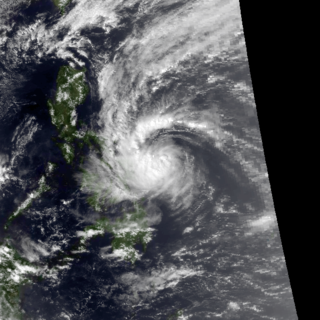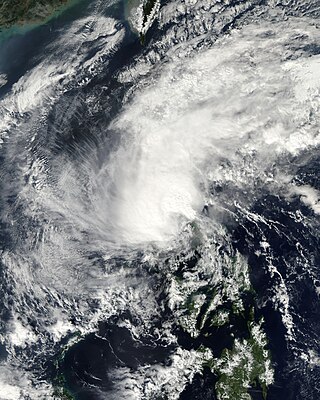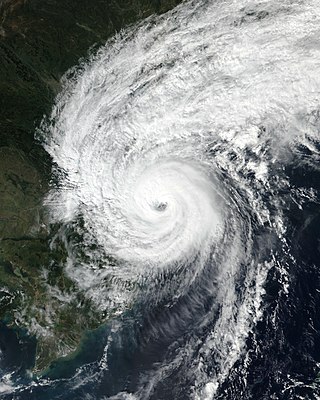From September 20 to 26, 1867, the capital Manila of the Captaincy General of the Philippines experienced the full brunt of a storm, which was believed to be a typhoon. [1] [2] Dubbed as the 1867 Angela typhoon, the capital was submerged in floods from the storm. Many ships either disappeared in waters or were destroyed in the shores near Santa Lucia and Tondo, both towns near Manila Bay. [1] The waves on the said bay were described as "mountainous" by some residents near the coast. [1] The Spanish ship that departed from British Hong Kong named "Malaspina" sank near the Ilocos Region, killing an unknown number of passengers and crew with no survivors. [1] [2] The waters of the Abra River overflowed, killing over 1,800 individuals, mostly due to drowning. [3] This would make the typhoon the fifth deadliest tropical cyclone ever to hit the present-day Philippines. [3] No numerical estimate for the damage caused by the storm is available. [1]
The system likely originated in the waters off the Philippine Sea, far back on September 20. It then started to curve northwestwards, passing over Luzon and emerging into Lingayen Gulf on an unknown date. It then turned westwards and was last noted on September 26 over the waters of the South China Sea, far away from any landmasses. This was recorded as the last known date of the typhoon, despite a barometric pressure report of 737.30 mm (29.027 inHg, 982.96 mbar) in Manila on the early morning of September 27. [1] [2]
The Malacañang Palace, which was the residence of then-governor-general José de la Gándara y Navarro, was isolated due to the floods. [1] The paths leading to the palace were submerged by an overflowed lake, forcing some officials there to use boats to reach the palace. [2] Typhoon-force winds were experienced in the capital and other surrounding areas for over 10 hours. [2] Over seventeen ships were still in Manila Bay when they experienced the fury of the storm. The vessels may have disappeared and/or been wrecked in the shores near the towns of Santa Lucia and Tondo. [1] Residents near the coast on these areas described the waves in the bay as “mountainous”. [2] Some officials and religious institutions provided assistance to residents that could not evacuate during the floods. [1]
| Rank | Storm | Season | Fatalities | Ref. |
|---|---|---|---|---|
| 1 | "Haiphong" | 1881 | 20,000 | [4] |
| 2 | Yolanda (Haiyan) | 2013 | 6,300 | [5] |
| 3 | Uring (Thelma) | 1991 | 5,101–8,000 | [6] |
| 4 | Pablo (Bopha) | 2012 | 1,901 | [6] |
| 5 | "Angela" | 1867 | 1,800 | [7] |
| 6 | Winnie | 2004 | 1,593 | [7] |
| 7 | "October 1897" | 1897 | 1,500 | [7] [8] |
| 8 | Nitang (Ike) | 1984 | 1,426 | [9] |
| 9 | Reming (Durian) | 2006 | 1,399 | [7] [6] |
| 10 | Frank (Fengshen) | 2008 | 1,371 | [nb 1] [10] [11] |
On September 5, the waters of the Abra River overflowed due to the typhoon, reaching over 25 feet above the spilling level. [1] [2] [12] This tragedy killed over 1,800 individuals of which the majority are due to drowning. [1] [2] It also caused an incalculable amount of damage in crops and livestocks across the Ilocos Region, especially Abra. [2]
A Spanish ship, dubbed as “Malaspina” which had departed on 20th Sep 1867 from British Hong Kong and was traveling to Manila, the Philippines, experienced the full force of the storm and sank, possibly in the South China Sea, on another unknown date. [1] [2] Nothing has been heard from the ship since then and the number of dead remains unknown. [2] As time passed, the families of the victims started to worry and suspicions started to emerge in the country. [1] [2] Some months later, the commandant of the navy yard in Manila started a widespread search for the ill-fated ship, all of which returned with no traces of the large vessel. [2] It was believed that until this day, the history of the ship remained unknown in human knowledge. [1]
After the typhoon's devastation in Luzon, the Ayuntamiento with the consent of Gándara distributed aid amounting to ₱3,000 to the victims of the storm. [1] A royal decree, which was signed on December 21 that year, described that the expenses were approved for recovery processes and the La Direccion de Administracion of the country were instructed to divide the budget for further emergencies. [1] [2]
Five months later, on February 18 of the next year, the Army and Navy of Cavite paid a tribute to the victims of the tragedy and their comrades that were also in that ship. [1] [2] The Santo Domingo Church in the area held a solemn high mass that day, to remember the loss of the passengers and crew of the ill-fated ship. [1] [2]

Tropical Storm Thelma, known in the Philippines as Tropical Storm Uring, was one of the deadliest tropical cyclones in Philippine history, killing at least 5,081 people. Forming out of a tropical disturbance on November 1, 1991, several hundred kilometers north-northeast of Palau, the depression that would become Thelma tracked generally westward. After turning southwestward in response to a cold front, the system intensified into a tropical storm on November 4 as it approached the Philippines. Hours before moving over the Visayas, Thelma attained its peak intensity with estimated ten-minute sustained winds of 75 km/h (45 mph) and a barometric pressure of 992 mbar. Despite moving over land, the system weakened only slightly, emerging over the South China Sea on November 6 while retaining gale-force winds. Thelma ultimately succumbed to wind shear and degraded to a tropical depression. On November 8, the depression made landfall in Southern Vietnam before dissipating hours later.
Typhoons in the Philippines can occur any time of the year, with the months of June to September being most active, with August being the most active individual month and May the least active. Approximately 20 tropical cyclones enter the Philippine area of responsibility yearly, an area which incorporates parts of the Pacific Ocean, the South China Sea, and the Philippine Archipelago. In each year, ten cyclones are usually expected to be typhoons, with five having the potential to be destructive ones. According to a 2013 Time Magazine article, the Philippines is "the most exposed country in the world to tropical storms". In the Philippine languages, tropical cyclones are generally called bagyo.

The 1922 Shantou Typhoon was a devastating tropical cyclone that caused thousands of deaths in the Chinese city of Shantou in August 1922. This total makes it one of the deadliest known typhoons in history.

Typhoon Fengshen, known in the Philippines as Typhoon Frank, was the sixth named storm and the fourth typhoon recognized by the Japan Meteorological Agency. The Joint Typhoon Warning Center recognized Fengshen as the seventh tropical depression, the sixth tropical storm, and fifth typhoon of the 2008 Pacific typhoon season.

Tropical Depression Winnie was a weak, but catastrophic tropical cyclone that killed nearly 1,600 people after triggering widespread flooding in the Philippines. It was the second deadliest tropical cyclone of 2004 worldwide, only surpassed by Hurricane Jeanne. A depression, which formed east of Samar, brought heavy rain to areas where it passed through, and affecting many areas, owing to Winnie’s large cloudiness.

Typhoon Amy was an intense and deadly tropical cyclone that struck areas of the central Philippines in December 1951. Impacting the archipelago during the 1951 eruption of Mount Hibok-Hibok, Amy exacerbated the effects of the volcano, greatly increasing the number of resulting deaths. The fifteenth named storm and fourteenth typhoon within the western Pacific Ocean that year, Amy developed from an area of low pressure near the Kwajalein Atoll on December 3. Tracking in a general westward direction, the storm quickly intensified to reach typhoon intensity the next day. However, the typhoon's asymmetricity resulted in a fluctuation of intensity over the following few days. Afterwards, Amy intensified to reach its peak intensity with maximum sustained winds of 220 km/h (140 mph) and a minimum barometric pressure of 950 mbar on December 8. Over the ensuing two days, Amy moved over several islands in the central Philippines before emerging in the South China Sea on December 11 as the equivalent of a minimal typhoon. Shortly after, the tropical cyclone executed a tight anticyclonic loop while oscillating in strength several times before eventually weakening and dissipating on December 17, just east of Vietnam.

The 1881 Haiphong typhoon was a devastating typhoon that struck Haiphong, in northern Dai Nam, and the northern part of the Captaincy General of the Philippines on October 8, 1881. The typhoon was first detected east of Southern Luzon on September 27, 1881. The typhoon killed about 23,000 people in total.

In 1900, 23 tropical cyclones were observed in the western Pacific Ocean, north of the equator and west of the International Date Line. In that region of the world, cyclones that attain maximum sustained winds of at least 118 km/h (73 mph) are known as typhoons. Of the 23 storms, 13 were tracked by the Hong Kong Observatory. Activity occurred from January to December, although the majority of the storms formed from June to November.
There were 30 tropical cyclones in the western Pacific Ocean in 1931, including 19 typhoons, as well as one that developed in December of the previous year. The most significant typhoon was one that struck eastern China near Shanghai in the midst of the country's worst floods on record; heavy rainfall caused levees to collapse along the Grand Canal, killing an estimated 300,000 people, including about 2,000 people overnight in the city of Gaoyou.
This article encompasses the 1850s Pacific typhoon seasons. The list is very incomplete; information on early typhoon seasons is patchy and relies heavily on individual observations of travellers and ships. There were no comprehensive records kept by a central organisation at this early time.
This article encompasses the 1860s Pacific typhoon seasons. The list is very incomplete; information on early typhoon seasons is patchy and relies heavily on individual observations of travellers and ships. There were no comprehensive records kept by a central organisation at this early time.
This article encompasses the 1870s Pacific typhoon seasons. While data is not available for every storm that occurred, some parts of the coastline were populated enough to give data of typhoon occurrences.
This article encompasses the 1880s Pacific typhoon seasons.
This article encompasses the 1890s Pacific typhoon seasons.

Typhoon Vamco, known in the Philippines as Typhoon Ulysses, was a powerful and very destructive Category 4-equivalent typhoon that struck the Philippines and Vietnam. It also caused the worst flooding in Metro Manila since Typhoon Ketsana in 2009. The twenty-second named storm and tenth typhoon of the 2020 Pacific typhoon season, Vamco originated as a tropical depression northwest of Palau, where it slowly continued its northwest track until it made landfall in Quezon. After entering the South China Sea, Vamco further intensified in the South China Sea until it made its last landfall in Vietnam.

Typhoon Flo, known in the Philippines as Typhoon Kadiang, was a catastrophic and deadly minimal typhoon that hit the northern Philippines during October 1993. It also caused the largest 72-hour forecast error for the year due to its interaction with the nearby Super Typhoon Ed. The twenty-seventh depression, twenty-second named storm and the eleventh typhoon of the 1993 Pacific typhoon season, Flo originated from an area of convection that was embedded from a monsoon trough during September 28. Two days later, a tropical depression formed within this trough, to the west of Guam. Slowly organizing, it remained a tropical depression until on October 2, when it strengthened to a tropical storm and was given the name Flo by the Japan Meteorological Agency. Slight wind shear from nearby Ed inhibited development; however, it intensified to a minimal typhoon as it neared the coastline of Luzon. On October 3, it made landfall near the Isabela-Aurora in its peak. It then crossed the country while weakening, and moved ashore near the South China Sea the next morning. It then unexpectedly moved back to the country due to its interaction with Ed, and it moved back to the Philippine Sea on October 17 before accelerating to the south of Japan. It then became extratropical on the next day.

Typhoon Olga, known in the Philippines as Typhoon Didang, was a strong typhoon that brought widespread damage to the Philippines in May 1976, causing what was called the "worst flooding in 30 years". The storm killed over 300 people and displaced over 1.3 million others. The storm originated from an area of several surface circulations on May 4, in which the JTWC first noted its predecessor as a southwestward-moving storm on May 12. However, it was first tracked by the JMA on May 11. Nevertheless, it strengthened to a tropical storm while continuing its motion and track. However, it weakened to a tropical depression as it slowly interacted with another circulation to its east, in which the new system dominated over the existing one. The JMA and JTWC still treated the storm as Olga as it entered the area of responsibility of the Philippines, in which the state weather bureau tracked the system as "Didang". Despite the presence of shear around the storm, the system slowly consolidated and grew as it neared the country and few hours prior to landfall, it rapidly intensified to a Category 3 storm before its landfall over Aurora on May 21. Upon inland, Olga subsequently weakened to a tropical storm as it slowed down over Central Luzon before finally exiting through the South China Sea on May 24. There, it slightly strengthened to a tropical storm as it neared land again, this time over Northern Luzon before becoming absorbed by a subtropical disturbance to the south of Okinawa on May 28, in which the JTWC last monitored the system one day prior. However, the JMA continued to track the system along with Olga's remnants until they dropped their advisories while near the International Date Line on May 31.